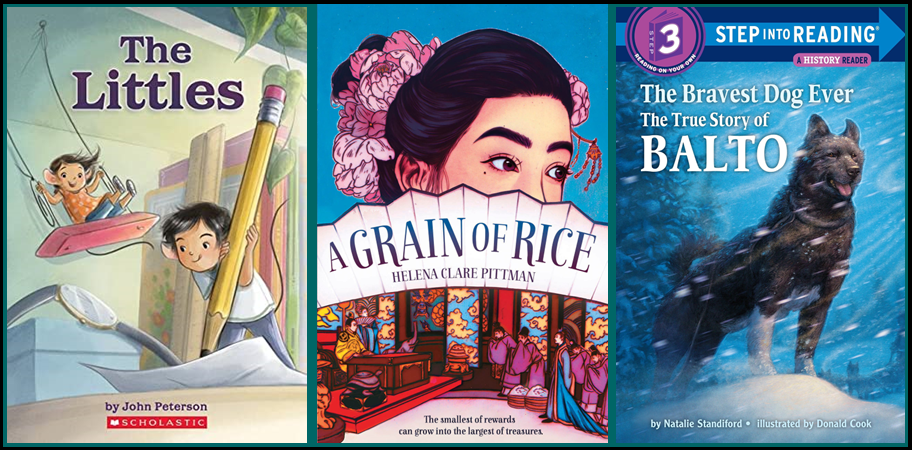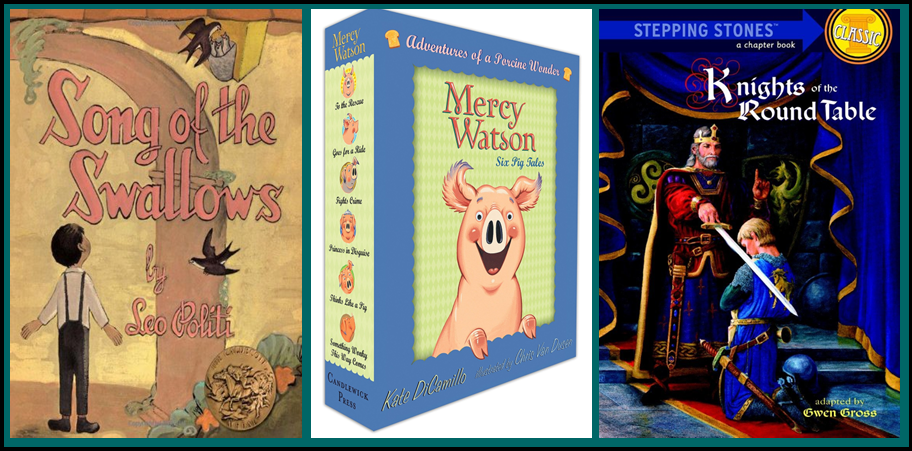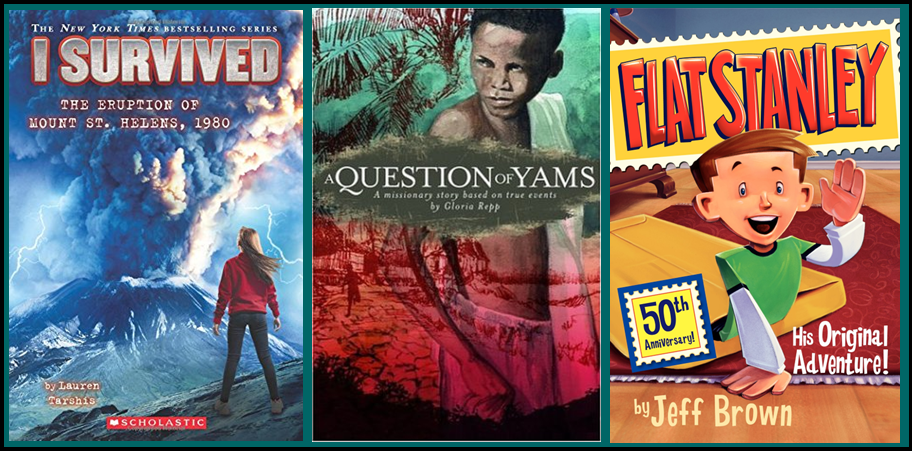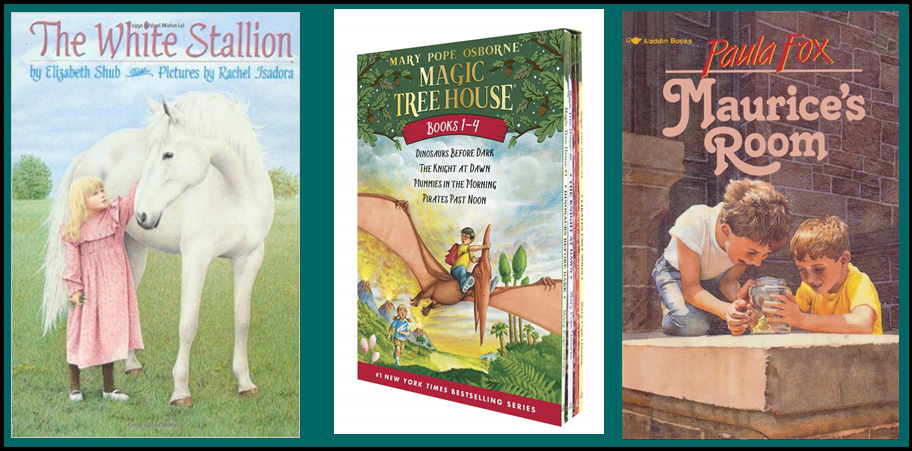I am in the process of updating my lit lists for homeschools of kids with special needs. Since I mainly teach older students with dyslexia, autism, or those who struggle with reading, I am always on the lookout for books that fit one of the many language arts goals in the individual learning plans for my students. This article is an alphabetical listing of easy chapter books appropriate for tweens and teens reading at a second or third grade level to practice reading independently or with some assistance.

My criteria for finding beginning chapter books for older students are:
- interesting stories,
- short chapters,
- 10 chapter and/or 100 pages or fewer,
- larger fonts,
- vocabulary of mostly one to two syllables,
- occasional pictures to further comprehension of the plot,
- clean language,
- solid literature purpose rather than trendy “junk reads,”
- not babyish (hard to find, so if a title in my list is too immature for your student, cross it off and look at another title

Note to secular homeschoolers and special education teachers: Some of the books in the list are Christian stories, but many are not. Keep in mind, my purpose is to provide a list of quality literature for older students reading at a second grade level. If you have a Christian homeschool, you will find many great reads for your kids – even the younger ones. If you have a secular homeschool, select those that work for your family or class. I have marked Christian titles with an asterisk.
I hope you find some titles that are helpful in getting your older student ready to begin reading independently or at least with assistance beyond decodable phonics readers. If you come across a title your tween or teen loved, please share it with me! I’m always scoping for titles that have some substantial content yet satisfy the unique needs of beginning readers with dyslexia or other reading struggles. Be sure to tell me the age of your student and whether you used it as a read-aloud, for independent reading, or listened to the audiobook.

80 Chapter Books at Grade 2 Reading Level for students with language-based learning needs. Select titles based on your reader’s needs.
- 100 Pounds of Popcorn
- A Bargain for Frances
- A Big Ball of String
- A Grain of Rice, Helena Pittman
- A Question of Yams, Gloria Repp (Journey Forth Books) *
- Abe Lincoln’s Hat (Step into Reading 3)
- Amelia Bedelia books
- Arthur Series, Marc Brown
- Astronaut: Living in Space (DK Readers 2)
- Balto, the Bravest Dog Ever (Step into Reading 3)
- Bark Park Series
- Berenstain Bears Chapter Books
- Biomes and Habitats – 10 Book Set, Teacher Created Materials
- Brave Clara Barton (Step into Reading 3)
- Cam Jansen Series
- Captive Treasure, Milly Howard (Journey Forth Books) *
- Carolina’s Courage, Elizabeth Yates
- Christian Liberty Press Nature Reader Book 1 *
- Christmas Crossroads, Elizabeth Raum (Journey Forth Books) *
- Christopher Columbus (Step Into Reading 3)
- Cora Frear, Susan Goodman
- Critter Inn Series
- Cul de Sac Kids books *
- Daniel’s Duck (I Can Read 3)
- Davey Crockett: A Life on the Frontier (Ready to Read 3)
- Dirty Joe, The Pirate: A True Story, Bill Harley
- Eagle Feather, Clyde Robert Bulla
- Edgar Allan Poe’s Tales of Terror (Stepping Stones 3)
- Flat Stanley
- George Washington and the General’s Dog (Step into Reading 3)
- Geronimo Stilton Book Series
- Helen Keller
- Hill of Fire (I Can Read 3)
- I Survived Book Series
- In a Dark, Dark Room and Other Scary Stories (I Can Read 2)
- In a Pickle and Other Funny Idioms
- Island Survival Series, Gordon Korman
- Jack Jones Book Series, Zander Bingham
- Josephina’s Quilt
- Journey of a Pioneer (DK Readers 2)
- Keep the Lights Burning, Abbie
- Knights of the Round Table (Stepping Stone)
- Lad, A Dog and Lad Lost
- Lewis & Clark: A Prairie Dog for the President (Step into Reading 3)
- Magic Tree House Series, Mary Pope Osborne
- Maurice’s Room, Paula Fox
- Mega Machines (DK Readers 1)
- Mercy Watson Series, Kate DiCamillo
- Molly’s Pilgrim
- Mouse Tales (I Can Read 2)
- My Father’s Dragon
- On Yonder Mountain, Milly Howard (Journey Forth Books) *
- Owl at Home (I Can Read 2)
- Prairie School (I Can Read 4)
- Pulling Together, Dawn Watson (Journey Forth Books) *
- Sam, the Minuteman
- Sarah Witcher’s Story, Elizabeth Yates
- Sarah, Plain and Tall
- Shoeshine Girl, Clyde Robert Bulla
- Song of the Swallow, Leo Politi
- Sticky Flies, Whirling Squirrels, and Plucky Ducks, Eileen Berry (Journey Forth Books)
- Stone Fox
- The Big Balloon Race (I Can Read 3)
- The Big Book of Silly Jokes for Kids
- The Camping Trip (I Can Read 2)
- The Chalk Box Kid, Clyde Robert Bulla
- The Courage of Sarah Noble
- The Dog That Stole Football Plays, Matt Christopher (Passport to Reading 3)
- The Hidden Village, Bonnie Hudson (Journey Forth Books) *
- The Hundred Dresses
- The Littles Series
- The Long Way to a New Land (I Can Read 3)
- The Long Way Westward (I Can Read 3)
- The Miraculous Journey of Edward Tulane, Kate DiCamillo
- The Statue of Liberty (Step into Reading 2)
- The Story of Neil Armstrong
- The Sword in the Tree
- The White Stallion
- Tippy Lemmey, Patricia McKissack
- Tornado, Betsy Byars
- Trains! (Step Into Reading 3)
- Twisters! (DK Readers 2)
- Vikings (National Geographic Kids 2)
- Wagon Wheels (I Can Read 3)
Now what?
Now that you have a good list of titles to pick from, what do you do with them? First, I seldom have my students write book reports. For my tween and teen students, I typically use a Literary Elements Graphic Organizer that you can get in my TPT store for FREE here. Sometimes, we do a character analysis using a graphic organizer, or a plot timeline, do a hands-on project to show the literary elements, or write a story in the style of the book they enjoy. Sometimes, I have students collect a specific literary device, like similes, alliteration, or irony. We usually have a discussion about the climax, what they liked or didn’t like, and any themes. Depending on the student, I may have them narrate in Charlotte Mason style each chapter as they read to be sure they are comprehending.

Here are some typical questions you can ask regardless of what book a kid is reading are. Don’t ask all of them at once! Asking just one or two questions will usually spark a rich discussion from an older learner.
- Who is the protagonist?
- Who or what is the antagonist?
- Is there anything you would change about the main character?
- What is the setting? The time? The place?
- Did the setting change as the story progressed?
- What is the problem or conflict?
- What is a major event in the story/plot that made a significant impact on the
characters? - How did the author use description or narration to move the plot along?
- Did you notice any ___ (name a literary device you have been teaching)___?
- Is there anything you would do differently if you were one of the characters?
- What was the main climax?
- Was there more than one climax? Why did the author put in more than one exciting part?
- How did the book end?
- Did you like the ending or would you have closed the story in
a different way? - Why do you think the author ended that way?
- If there is a sequel to this book, would you want to read it? Why or why not?
Watch for my next list of Grade 3 chapter books for older students with dyslexia or other language-based reading issues!
You will also get the FREE Learning Plan Success KIt. If you are new to homeschooling, I’m sure you will find ideas that can help you get started with a solid plan rather than becoming overwhelmed with where to start looking for curriculum. If you have been homeschooling awhile and feel stuck the Learning Plan Success Kit may help you to regroup and find new encouragement that you are not alone!
If you ever have a question or need encouragement or help with brainstorming ideas, feel free to email me at: sueh@uniquelearnerssh
Happy Reading!
Sue Hegg
